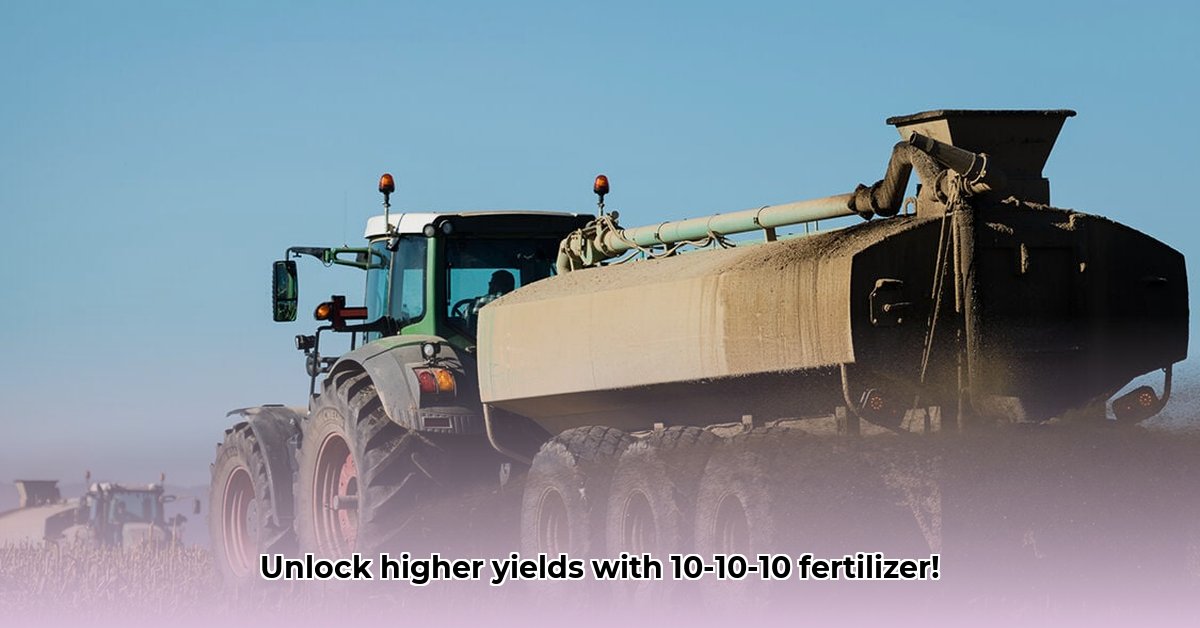
Getting the most from your garden or farm often involves fertilizer. 10-10-10, readily available at Tractor Supply, is a popular choice, but is it the best choice for sustainable yields? This guide explains how to use 10-10-10 effectively and responsibly, maximizing its benefits while minimizing environmental impact. For alternatives to chemical fertilizers, consider exploring other options.
Understanding 10-10-10: Decoding the Numbers
The "10-10-10" signifies the percentage, by weight, of three essential plant nutrients: Nitrogen (N), Phosphorus (P), and Potassium (K). Thus, a 10-10-10 fertilizer contains 10% nitrogen, 10% phosphorus, and 10% potassium. This balanced formulation makes it versatile for various plants and growth stages. However, is a perfectly balanced nutrient profile always ideal? Let's explore that. Over-reliance on 10-10-10 without understanding soil needs can lead to nutrient imbalances and environmental concerns. Soil testing, therefore, is crucial.
Soil Testing: The Cornerstone of Sustainable Fertilization
Before applying any fertilizer, understand your soil's nutrient levels. A soil test provides this vital information, guiding you toward the most effective fertilization strategy – which may or may not include 10-10-10. This prevents over-fertilization, saving you money and protecting the environment. Think of it as a preventative health check for your soil.
How to Conduct a Soil Test:
- Sample Collection: Collect multiple soil samples from different areas of your garden or field, aiming for about a cup per sample. Mix them thoroughly for a representative sample.
- Lab Analysis: Submit your sample to a local agricultural extension office or a commercial soil testing lab. Many offer affordable services.
- Interpreting Results: The lab report details nutrient levels (N, P, K, etc.), indicating deficiencies or excesses. This informs your fertilizer choices and application rates.
- Determining Application Rate: Based on the soil test and your plant's requirements, determine the appropriate amount of 10-10-10 (or alternative fertilizer) needed.
Applying 10-10-10: Techniques for Maximum Efficiency
Proper application is key to maximizing nutrient uptake and minimizing environmental impact. Avoid simply broadcasting fertilizer; instead, consider targeted methods.
- Banding: Applying fertilizer in narrow strips near plant rows concentrates nutrients where they're needed.
- Side-dressing: Applying fertilizer along the side of established plants delivers nutrients directly to the root zone.
- Timing: Apply 10-10-10 according to the package recommendations and your specific crops' needs. Early spring or at planting is often ideal.
Choosing the correct application method directly impacts environmental responsibility. Broadcasting can lead to excessive runoff, so targeted application is always preferred.
Sustainable Alternatives: A Holistic Approach
While 10-10-10 offers convenience, sustainable practices enhance soil health and reduce environmental impact. Consider integrating these:
- Composting: Compost enriches soil, improves structure, and reduces the need for chemical fertilizers.
- Cover Cropping: Planting cover crops between main crops improves soil health and reduces erosion.
- Crop Rotation: Rotating crops prevents nutrient depletion and supports soil biodiversity.
Integrating these practices alongside 10-10-10 creates a synergistic effect, leading to healthier plants and a more sustainable agricultural system. "A balanced approach, combining both conventional and sustainable practices, is most effective," notes Dr. Emily Carter, Soil Scientist, University of California, Davis.
Troubleshooting and FAQs
- Plant Burn: Over-fertilization can damage plants. Always follow recommended application rates.
- Nutrient Deficiencies: Soil tests inform you of nutrient needs; 10-10-10 might not address all deficiencies.
- Runoff: Avoid applying fertilizer before rain; use methods minimizing runoff.
Remember, responsible fertilizer use is only part of sustainable agriculture. Soil health, water management, and pest control are equally important. Using 10-10-10 judiciously and integrating sustainable practices leads to healthier plants and a healthier environment.
Key Takeaways:
- Soil testing is paramount for responsible fertilizer use.
- Precision application techniques maximize nutrient uptake and minimize environmental impact.
- Integrating sustainable alternatives enhances soil health and reduces reliance on chemical fertilizers.
- Monitoring and troubleshooting ensure efficient and responsible fertilizer use.